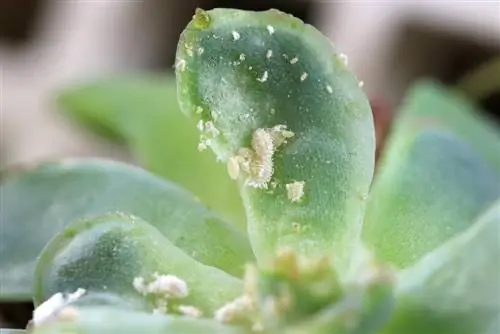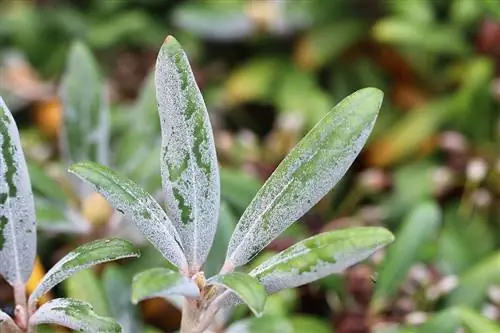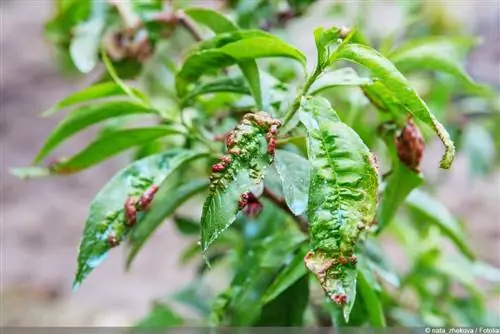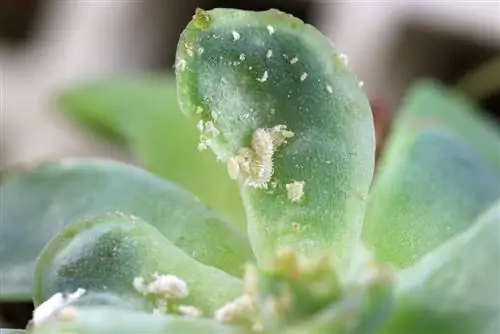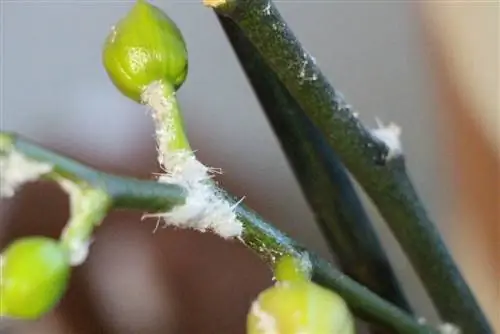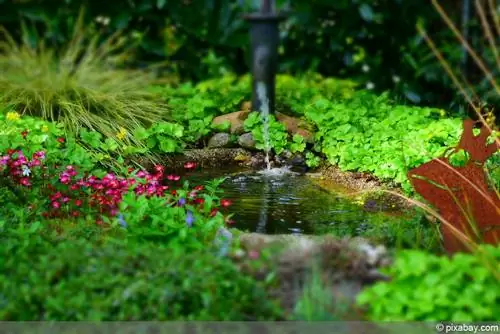- Author admin [email protected].
- Public 2023-12-17 03:39.
- Last modified 2025-01-24 12:45.
Most mealybug species prefer herbaceous plants, especially grasses, daisies and legumes. The insects can quickly become a nuisance and should therefore be collected or combated with special solutions.
The damage caused by mealybugs
The first thing you usually notice are the cotton-like white webs on your plants, which are reminiscent of small pieces of lint. These are frayed wax scales or a web of wax that the insects use to protect themselves from predators. The animals are oval-shaped and usually between 3 and 7 mm in size, but can be even longer. On the back of the pests you will find characteristic transverse grooves that divide the individual body segments.
The mealybugs look very similar, although the web looks more like powder and is reminiscent of dust. The animals are mainly found on the axes and branches of plants or on the undersides of leaves. Special species also attach themselves to roots and are visible either on the individual roots or on the walls of the planters. The animals bite on the plant parts and damage plants by removing the plant sap, which is important for transporting nutrients. The insects also secrete honeydew, which attracts fungi and can lead to the transmission of infections. Affected leaves can turn yellow, shoots wither and the growth of the entire plant is inhibited. The honeydew can be black due to fungal colonization. Outdoors, mallows, hydrangeas, boxwood and ivy are often affected. When it comes to houseplants, herbaceous plants are usually affected, such as succulents, orchids, but also palm trees and cacti.
Fighting mealybugs biologically
An important measure to prevent insects and scale insects is to regularly check the plants. Infected plants should be separated from plants that are still he althy in order to prevent the rapidly multiplying insects from spreading. The pests are usually introduced through new purchases, so it can generally make sense to separate newly purchased plants first to test whether they are infested with mealybugs. Individual animals can be collected, for example with a cotton swab. Another way to combat it is with oil preparations. Rapeseed oil in particular is often well tolerated by plants. Soft soap, mixtures with detergent or spirit (e.g. dilute 15 grams of soap with spirit and dissolve in about a liter of water) as well as brandy and vodka can also get rid of the uninvited guests. It is important to note the following:
- Individual affected areas can be treated with a cotton ball that you soak in the solution. Use it to thoroughly wipe the leaves and especially the underside. Oil and alcohol soften the skin of the insects and kill them.
- You can also use neem oil. The extract of the Indian neem tree surrounds the insects so that they suffocate under the oil.
- Instead of rubbing the plant parts individually with the solution, you can also hose them down completely with the mixture.
- Check the tolerance of the product on a branch in advance and observe in the following days whether any irritation occurs. Many orchids, for example, cannot tolerate oils.
- Make sure that you really hit the mealybugs and mealybugs directly. The plant should be well wetted so that the solution drips from the leaves.
- When treating with oil, the plants should not be placed in direct sunlight, otherwise burns may occur.
- If you use dishwashing liquid, you should wipe the solution off again with clear water after leaving it to work for at least 10 minutes or spray the plant with water, as the dishwashing liquid can damage the pores.
- Very heavily infested plant parts should be cut off immediately, as there is a high probability that the animals will appear again and again.
- Then place the plant in new substrate and repeat the procedure after 14 days in order to catch any lice that have hatched afterwards.
For biological control, you can also use beneficial insects that you can purchase from specialist retailers. The Australian ladybird, for example, eats mealybugs and helps you naturally rid affected plants of pests.
Complementary chemical agents

Sometimes the pests are so stubborn that home remedies or biological methods are not enough to get rid of the insects. Precisely because the animals can hide in the substrate or in the ground and new mealybugs always hatch from overlooked eggs, chemicals are sometimes necessary to eliminate the infestation. Appropriate means include combination sticks, ornamental plant sprays or special substrate products that you add to the bow. The sticks must be inserted into the root ball. If you have hydroponic houseplants, you can alternatively place them in the water in the planter or saucer. The effect may take a few days to appear. You should apply the sprays from a certain distance (around 30 cm) as they are usually cool and otherwise damage the leaves. Place the affected plants outside to spray and shower the killed mealybugs with warm water.
What you should know about mealybugs and mealybugs in brief
The mealybug, also known as the mealybug, belongs to the superfamily of scale insects. Mealybugs are plant pests and therefore live there. They can reach a height of approximately 3-6 mm. They also have a special cold-repellent skin that makes them resistant to cold. Temperatures down to minus 40 °C are no problem for mealybugs.
When do you have to limit mealybugs?
The faster the better is clearly the motto here, because these small animals are capable of producing up to eight new generations in a year. That's a lot of mealybugs, so you shouldn't let it get that far. However, when you notice the infestation, it is usually already at a somewhat more advanced stage: As a rule, a mealybug infestation is only noticeable when a downy coating can be seen on or under the leaves, which means that the next generation is already developing.
How do you go about combating mealybugs?
If the tiny creatures attack your houseplants, it is best to take action immediately.
The following defensive measures are recommended in order:
- All infested plants should be immediately separated from plants that do not yet show any signs of infestation so that the mealybugs cannot spread any further.
- If you have a mealybug infestation, you should check the growing conditions of the plants because an infestation indicates that the plants are weakened.
- For smaller infestations, you could try removing the mealybugs from the leaves by hand, e.g. B. using an alcohol-soaked cotton swab.
- The above-mentioned addition of paraffin oil or dish soap also helps to dissolve the waxy layer of the skin, but unfortunately these treatments usually have to be repeated several times.
- The oil-soap treatment is not suitable for every houseplant, e.g. B. Orchids are said to suffer from this type of control.
- Some species of mealybugs also attack the roots of plants; they can be controlled by rinsing the roots and planting them in new soil.
- If many plants are severely infested, only the use of biological pesticides will probably help.
- The Australian ladybirds “Cryptolaemus montrouzieri”, which you can find for example, should be particularly suitable. B. can order from Wabshop24 GmbH at www.wabshop24.de.
You can prevent infestation with mealybugs or mealybugs if, when purchasing your houseplants, you think about whether you can really offer them optimal conditions in your home in terms of temperature, lighting and nutrient supply. If this is not the case, it may be more convenient to choose a better-suited houseplant straight away rather than waiting for the languishing plant to become infested with pests.
Endangered Plants
Most mealybug species prefer herbaceous plants, especially grasses, daisies and legumes. Mealybugs multiply very quickly and lay hundreds of eggs, especially when it is a little warmer. The strong reproduction then leads to many more plant species being attacked by the mealybugs. These include, for example, sugar cane, grape vines and pineapples, orchids and cacti. Mealybugs also have a great preference for citrus plants.
Since the animals are very easy to recognize, you can quickly see which pest has attacked the plant. They attach themselves to the plants. The females' bodies are usually covered with a white, mealy excretion. The mealybugs also have a waxy layer or wax strips that cover the body and thus protect it from the cold.
What can you do against mealybugs or mealybugs? Biological control can be carried out with the help of the parasitic wasp or the ladybird; they are the natural enemies of the mealybug. Parasitic wasps can be purchased at a garden center or directly from a gardener. The lacewing is also one of the natural enemies of the mealybug.
In winter, a mixture of water and paraffin oil has proven to be effective. To do this, add about 10g of paraffin oil per liter of water to a container and mix these substances with the help of a little dishwashing liquid. The detergent also has the pleasant side effect of destroying the animals' wax shell. This product is also available as a ready-made mixture for spraying in specialist shops.

